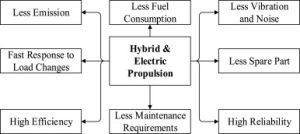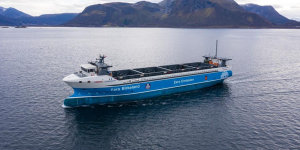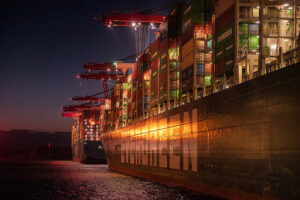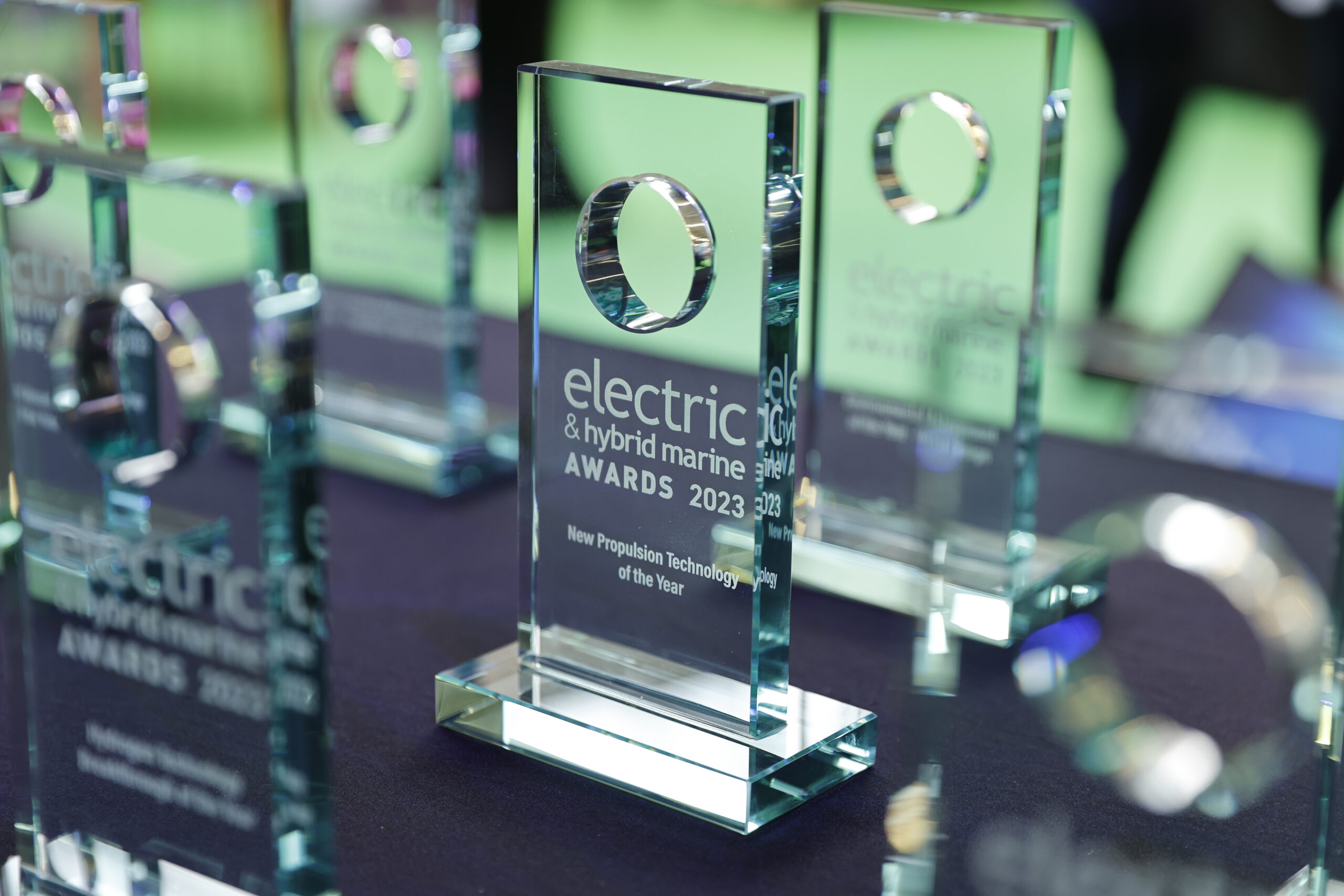The International Maritime Organization (IMO) has set ambitious targets to reduce the carbon intensity of international shipping by at least 40% by 2030 compared to 2008 levels, with a long-term goal of reducing total annual greenhouse gas (GHG) emissions by at least 50% by 2050.

Alternative fuel
Global trade relies on shipping, and that demand is increasing. Additional distances are being traveled due to disruption in the Red Sea, which is preventing ships from going across the Suez Canal – a shorter route for ships to take between Europe and Asia. With routes now taking 30% longer because they are having to circle the African continent, some shipping companies are exploring alternative fuels like liquefied natural gas (LNG) as a cleaner option. However, LNG still emits GHGs and has been criticized for not being a sustainable long-term option.
The industry, in turn, is turning toward greener fuels such as methanol, ammonia and hydrogen. For example, AP Moller-Maersk, one of the world’s largest integrated logistics companies, has set out a series of targets to tackle its GHG emissions across its operations.
Maersk aims to achieve a 35% reduction in Scope 1 emissions by 2030 and an impressive 96% reduction in Scope 1 and 2 emissions by 2040. Additionally, the company also plans to cut Scope 3 emissions by 90%, all of which is possible due to the introduction of methanol-fueled container ships. However, transitioning to greener fuels is not without its challenges. It requires the retrofitting of existing ships or building new ones with different engines and fuel storage systems. That’s coupled with the production of green fuels, like methanol, still being in its early stages and needing advances and investment in sustainable production methods.
Battery electric propulsion
Although the alternative fuels mentioned are gaining traction in the shipping industry, electric and hybrid propulsion technologies are also viable options for decarbonizing maritime transportation. For example, the e-ferry Ellen, operating in Denmark, is one of the first fully electric, zero-emission ferries in the world, carrying roughly 30 vehicles and 200 passengers, powered by what was the world’s largest battery at its time. Developed by Leclanché of Switzerland and reported to be designed with a lithium-ion system, Ellen’s batteries are split between two rooms below deck and have a capacity of 4.3MWh. Crucially, this allows the e-ferry to travel longer distances than most electric ferries – up to 21.4 nautical miles or nearly 38km – before needing to recharge.

Hybrid propulsion
Likewise, hybrid propulsion systems are being increasingly recognized as a practical and effective option for reducing emissions in the maritime sector. In fact, such technology is already being implemented in various types of vessels, such as offshore supply vessels. These often operate in sensitive environmental areas where emissions need to be minimized, and the hybrid systems enable them to run on electric power during drilling operations or when stationary, significantly reducing their environmental impact.
What’s more, short sea and commuter ferries also benefit greatly from hybrid systems. For example, the Color Hybrid, operating in Norway, uses a hybrid propulsion system to reduce emissions and noise during port operations, switching to diesel power for longer sea journeys. Another notable example is the Wärtsilä HY hybrid power module. Integrating engines, energy storage systems and power electronics optimized to work together through a newly developed energy management system (EMS), this marked the marine sector’s first hybrid power module of this type.
Energy efficiency
Both on board vessels and on shore, automation is increasingly being used to achieve increased efficiency. The integration of Maritime Autonomous Surface Ship (MASS) technology with hybrid propulsion systems offers a significant opportunity to enhance the efficiency and sustainability of maritime operations.
MASS, as defined by the IMO, refers to a vessel capable of operating with varying degrees of autonomy. Tsvetkova and Hellstorm (2022) studied the value creation potential of MASS and found that AI-enabled MASS will reduce inefficiency in the overall logistics chain. This is not only through the optimization of ship operations, such as route optimization and energy efficiency, but also other inter-related tasks, such as cargo handling operations. However, MASS requires sophisticated control systems to operate autonomously, making decisions and executing actions without direct human intervention.
In essence, control technology is the green key to cleaner seas by enabling the automation of various shipboard functions, including propulsion.
Control technology
Beckhoff’s PC-based control software offers a comprehensive automation solution that integrates PLC, motion control, robotics and IoT functionalities on a single platform. Core features include real-time data processing, scalability, modularity and compatibility with various communication standards like MQTT, OPC UA and EtherCAT.
Over the years, the software has evolved by incorporating advanced energy management systems, real-time monitoring and control capabilities tailored for marine applications. This evolution extends to the support of hybrid and electric propulsion systems, ensuring optimized fuel efficiency, reduced emissions and seamless integration with MASS technologies. Here, it integrates with MASS control systems and sensors through open interfaces and communication standards, ensuring efficient data exchange and decision making.
By integrating various sensors and data inputs through standardized communication protocols like EtherCAT, reliable and fast data transfer can happen between subsystems to ensure coordinated operations and optimal performance across a vessel’s systems. In terms of propulsion technologies, this means that the software provides immediate analysis and response to changing conditions, ensuring timely adjustments in propulsion control and other critical operations.

What’s more, the software’s scalability also means it can adapt to the specific needs of different types of vessels and levels of autonomy. For small boats, it offers compact, efficient control solutions, while for large ships, it provides robust, integrated systems capable of managing extensive and intricate operations. Meanwhile, the modularity of Beckhoff’s control software enables users to select and integrate only the necessary modules for their specific vessel requirements. This flexibility creates customized solutions that enhance efficiency and performance by addressing unique operational needs, from propulsion control to energy management and beyond.
Today, we are not only seeing increased adoption of hybrid and electric systems and a growing focus on sustainability, but also a trend toward integrating AI and autonomous capabilities to optimize operations and enhance efficiency. This, coupled with the challenges of compatibility with diverse propulsion technologies and meeting stringent regulatory standards, led Beckhoff to expand its portfolio to enhance its software to support AI.
So, despite learning that maritime shipping contributes more total greenhouse gas emissions than the international airline sector, the real takeaway is that the combination of green propulsion technologies and advanced automation helps to create a more sustainable shipping industry. With communication standards of MQTT, OPC UA and EtherCAT, Beckhoff’s PC-based platform is well suited for integrating with the systems required both on board vessels and onshore to establish a more improved environmental performance.
FAQ: Electric & Hybrid Propulsion in Maritime Decarbonization
1. What are electric and hybrid propulsion technologies in shipping?
Electric propulsion relies entirely on battery-powered systems (e.g., the e-ferry Ellen), while hybrid systems combine electric power with traditional fuels (e.g., diesel or LNG) for flexibility and emission reduction.
2. How do electric ferries like Ellen contribute to decarbonization?
The Ellen e-ferry (4.3MWh battery capacity) operates emission-free, covering 21.4 nautical miles per charge. It demonstrates that electric vessels are viable for short-sea routes.
🔗 Leclanché’s Ellen Project
3. What are the benefits of hybrid propulsion systems?
Hybrid systems (e.g., Wärtsilä HY module) reduce emissions by:
-
Using electric mode in ports/sensitive areas (e.g., Color Hybrid ferry).
-
Switching to fuel for long voyages.
🔗 Wärtsilä Hybrid Solutions
4. How does automation improve energy efficiency?
Maritime Autonomous Surface Ships (MASS) and AI optimize:
-
Route planning.
-
Fuel consumption (e.g., Beckhoff’s control software).
🔗 IMO on MASS
5. What role does control technology play?
Beckhoff’s PC-based systems integrate propulsion, energy management, and IoT via EtherCAT/OPC UA, enabling real-time adjustments for efficiency.
🔗 Beckhoff Marine Automation
Conclusion: The Future of Green Shipping
The maritime industry is transitioning toward electric/hybrid propulsion and AI-driven automation to meet the IMO’s 2030/2050 emissions targets. Key takeaways:
-
Electric ferries (e.g., Ellen) prove zero-emission viability for short routes.
-
Hybrid systems (e.g., Color Hybrid) balance flexibility and sustainability.
-
Automation (MASS, Beckhoff’s software) enhances efficiency through real-time data.
While challenges like battery limits and regulatory hurdles remain, these technologies are critical for a low-carbon shipping future.
External Sources for Further Reading
-
IMO’s GHG Strategy: International Maritime Organization
-
Leclanché’s Marine Batteries: Leclanché Solutions
-
Wärtsilä Hybrid Power: Wärtsilä Marine Technologies
-
Beckhoff Automation: Beckhoff Marine Systems
-
MASS Research: Tsvetkova & Hellström (2022)


That`s great.